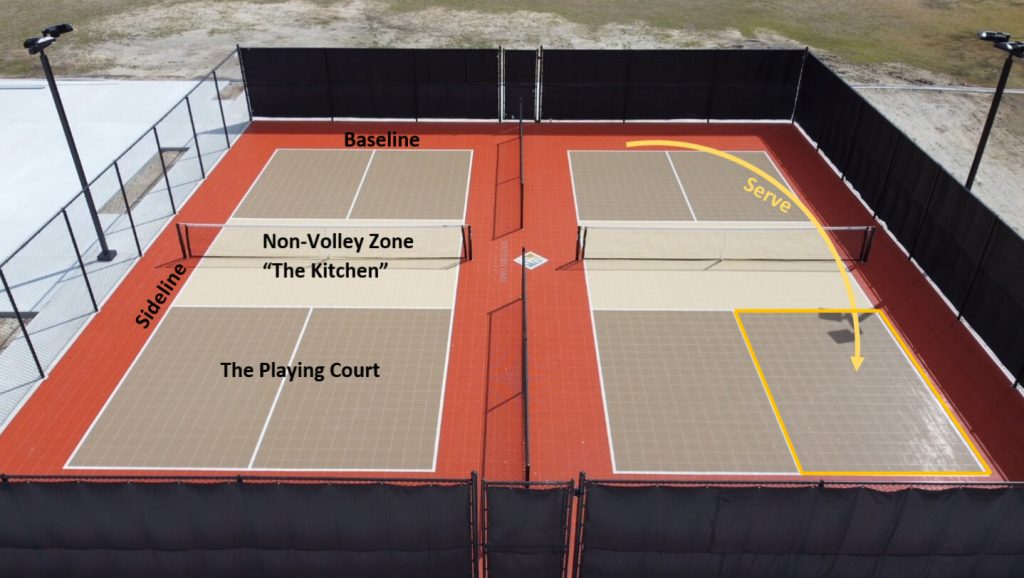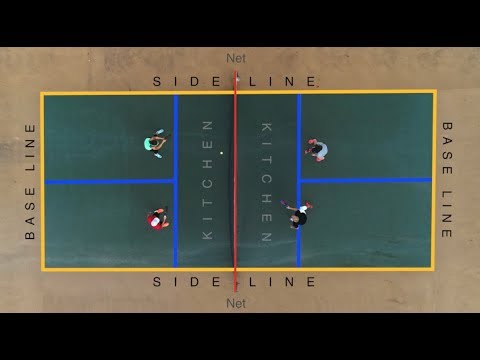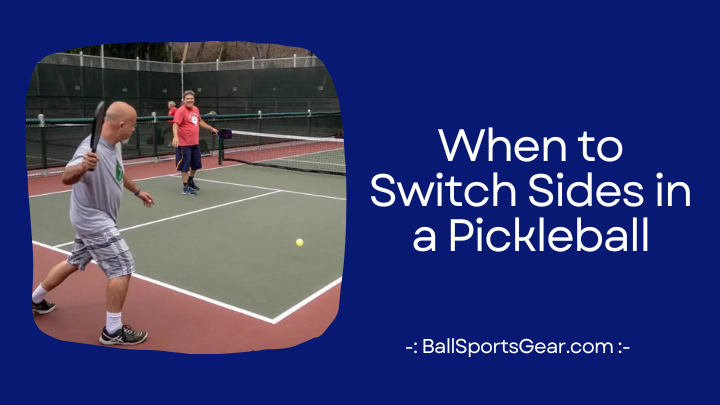Are you tired of being stuck on the same side of the court in pickleball? Do you find yourself wondering if it’s time to switch things up and try out a new position? Switching sides can be intimidating, but it could also be just what your game needs to take it to the next level. In this post, we’ll explore when and why you should consider switching sides in pickleball, so grab your paddle and let’s get started.
Rules of Pickleball
A plastic ball with holes and a paddle are used to play the game. The court resembles a badminton doubles court. The player must win by two points in order to win the game with a total score of 11. Prior to being returned, the ball must first bounce once on the opposing side of the court after being served diagonally by the serving team. The opposing team will score if the ball does not bounce or is struck out of bounds.
- The game is available in two or four player versions. Players have a choice of game modes, including competitive family games or social games with friends. Based on the number of players, different strategies are also possible. You can concentrate on one tactic and outsmart your opponent with the help of two players. Players with four need to think more carefully and strategically. The game is made more complex by the fact that players also need to take other players’ responses into account.
- To score a goal, the ball must cross the goal line and land on the opposing team’s court from the left side of the court. It counts whenever the ball crosses the goal line and lands on the opponent’s court from the left side.
- A player may not hit the ball twice in a row. Players are not allowed to tamper with the ball in order to outwit their opponents thanks to this rule. Additionally, the system makes sure that no player has an unfair advantage over the other.
- A fault occurs when a player serves the ball outside of the proper diagonal service court, the ball goes out of bounds, hits the net and doesn’t clear it, or if a player hits the ball outside the court.
- If the ball hits the top of the net and lands in the proper service court, the serve is considered a let and the server gets to serve again.
- Each team must hit the ball once after the serve and return of serve before hitting a volley. The “double bounce rule” applies here. The players may then strike the ball before it bounces again after it has made one bounce on each side.

The Basics Of When To Switch Sides
You must be aware of when to switch sides when playing pickleball. Switching is required after every 11 points is the basic rule. A few situations do not apply to this generalisation, though. In order to continue playing fairly, a player who has a score of 10 and another who has a score of 2 must switch sides because the player with the higher score only needs one more point to win.
They must play one more point if both players have a score of 10. Whoever wins that point gets to choose which team they want to play for in the following contest. Players occasionally decide to switch sides before the game is over. One player might request to switch sides with their opponent if they are feeling worn out or uncomfortable on their current side, for instance. This is permitted if both players concur.
Factors That May Influence When To Switch Sides
When deciding when to switch sides in a pickleball game, there are a few things to think about. The score comes first. It might be time to switch sides if you and your partner are losing by a significant margin. This will allow you to start over on the opposing side of the court, which could help you change the course of the game. Your level of fatigue is another thing to take into account. Switching sides can allow you to take a break while your partner takes over if you are feeling worn out. Finally, consider the advantages and disadvantages of your rival. You might find it advantageous to switch sides if they appear to be having trouble on one side of the court.
Switch sides after each point
In pickleball, the serving team always serves from the right-hand side of the court. If you win the point, you get to serve from the left-hand side. By switching sides after each point, you can take advantage of the different angles and wind conditions on each side of the court.
Switch Sides If You Are Struggling
Alternate sides Try hitting your forehand on the left side of the court if you are having trouble with your backhand on one side of the court, for example. Switch to the left side if you are having trouble hitting your backhand there because you will find it easier to hit your forehand there.
Switch Sides To Disrupt Your Opponents
On the tennis court, alter your strategy to disrupt your opponents’ rhythm and make it more difficult for them to anticipate your next move. Try switching to the left and making cross-court shots if you frequently make shots down the middle on the right side. By forcing your opponent to alter their position, you may be able to create new scoring opportunities and angles. You can keep your adversary off-balance and make it harder for them to block your shots by making unexpected movements.
Factors That May Influence When To Switch Sides
When deciding when to switch sides in a pickleball game, there are a few things to think about. The score comes first. It might be time to switch sides if you and your partner are losing by a significant margin. This will allow you to start over on the opposing side of the court, which could help you change the course of the game.
Your level of fatigue is another thing to take into account. Switching sides can allow you to take a break while your partner takes over if you are feeling worn out. Finally, consider the advantages and disadvantages of your rival. You might find it advantageous to switch sides if they appear to be having trouble on one side of the court. It might be advantageous for you to switch sides so that you can confront them from their weaker angle if they appear to be having trouble on one side of the court.

Tips For Communicating With Your Partner About Switching Sides
It’s crucial to communicate with your partner when playing pickleball together about when one of you wants to switch sides. Having clear communication can help players stay focused and have fun during the game.Here are some tips for communicating with your partner about switching sides:
- Make sure both partners are on the same page before the game starts. Discuss who will start on which side, and agree on a signal that either player can use to indicate when they want to switch sides.
- Try to switch sides after each few points, if at all possible. This will maintain fair play and keep one player from growing weary or frustrated.
- If you need to take a break during the game, be sure to let your partner know. They may need to switch sides in order for the game to continue fairly.
- Throughout the game, pay attention to your partner’s body language. Ask them if they would like to switch sides if they appear to be interested.
- Lastly, don’t be afraid to ask your partner for help if you’re not sure when or how to switch sides. They likely have more experience with the game and can offer guidance.
How To Practice And Improve Your Ability To Switch Sides
If you play pickleball, you are aware that being able to switch sides quickly is one of the game’s most crucial abilities. This enables you to take advantage of your opponent’s position while also keeping up with the rally. But how do you train and hone your side switching skills?
Playing against a wall is among the best ways to practise. You can practise your footwork and racquet control without being concerned about your opponent thanks to this. Utilizing a ball machine is a fantastic additional practise method. You’ll be able to build muscle memory and increase your endurance as a result.
Finally, get ready for your game by warming up. Pickleball is a quick game, and switching sides can be physically demanding. You can prevent injuries and perform at your peak when the game begins by warming up.
Common Mistakes To Avoid When Switching Sides
When changing sides in a pickleball game, it’s important to keep your paddle low in order to avoid a common error. You won’t be able to reach the ball and make a good shot if you keep your paddle too high. Keeping your feet still is another error. In order to be prepared to move quickly to reach the ball, you should always be moving your feet and keeping your weight on your toes. Remember to keep your focus on the goal at all times, too. Even for a split second, you risk missing the ball as it approaches you if you look away from it.
Frequently Asked Questions
You will switch sides after every odd numbered game. So, if you win the first game, you will stay on that same side for the second game. If you lose the first game, you will switch sides for the second game. You will then alternate sides for each subsequent game until the end of the match.
The best way to keep track of when to switch sides is by using a scorekeeper or keeping track of the games yourself. That way, you can focus on playing and not worry about forgetting to switch sides.
Switching sides allows each player an equal opportunity to serve from both left and right court areas. It also gives players a chance to rest on one side of the court while their opponent is serving from the other side.
Conclusions
Anyone who wants to advance in their pickleball game must master the art of knowing when to switch sides. You can master this technique and step up your game by learning the rules and taking your time to practise. You should be able to switch sides effortlessly and quickly after keeping these suggestions in mind.

